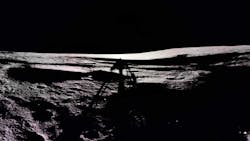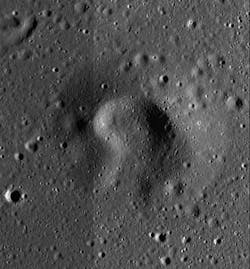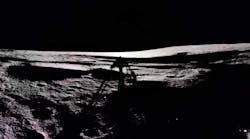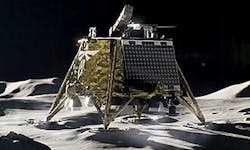Why Power Density Was Important for NASA’s Lunar Reconnaissance Orbiter
What you’ll learn:
- Details about the Lunar Reconnaissance Orbiter (LRO) power-system design.
- How power density was increased in radiation-hardened computer hardware.
The NASA LRO Power System Electronics (PSE) architecture includes reliable standard internal and external communication buses, solid-state circuit breakers, and lithium-ion battery charge management. In industrial automation, optimizing parameters and rising-edge dead time can help minimize losses and improve power density.
The LRO began its mission in 2009 and orbited the Moon for at least one year. Its mission was to 3D map the Moon to locate future landing sites and resources, including deposits of water ice shadowed in lunar polar craters. The LRO continues to orbit the Moon even today, providing images and precise locations of lunar landers and equipment from current and previous lunar missions, including the Apollo sites.
The first private spacecraft to successfully land on the Moon was Odysseus. This lunar lander was built by Intuitive Machines, a Houston-based company. It touched down near the lunar South Pole on February 22, 2021.
In 2024, the LRO confirmed the highly accurate landing site of the first successful Japanese Smart Lander for Investigating Moon (SLIM) in a soft landing.
Firefly’s Blue Ghost Mission
The LRO was able to image Firefly Aerospace’s Blue Ghost Mission 1, named “Ghost Riders in the Sky,” with a lunar lander on the Moon’s surface on the afternoon of March 2, 2025 — just under 10 hours after the spacecraft landed. The landing site was at the Mare Crisium (a.k.a. Sea of Crises) close to the Mons Latreille (a solitary lunar mountain in central Mare Crisium). That mountain rises 150 meters high above the surrounding Mare (Fig. 1).
Firefly Aerospace completed 14 days of surface operations on the Moon (346 hours of daylight). Blue Ghost 1 operated for more than five hours into the lunar night. The final data was received at around 6:15 PM CDT on March 16, 2025. This effort is the longest commercial operation on the Moon to date.
After Firefly’s perfect lunar landing, the team began surface operations to retrieve all 10 NASA payloads with the best scientific data possible during the lunar daylight.
>>Download the PDF of this article, and check out the Series Library for power-density-related articles and videos
Jason Kim, CEO of Firefly Aerospace, was elated and commented, “We’re incredibly proud of the demonstrations Blue Ghost enabled from tracking GPS signals on the Moon for the first time to robotically drilling and collecting science deeper into the lunar surface than ever before. We want to extend a huge thank you to the NASA Commercial Lunar Payroll Services (CLPS) initiative and the White House administration for serving as the bedrock for this Firefly mission. It has been an honor to enable science and technology experiments that support future missions to the Moon, Mars, and beyond.”
Blue Ghost 1 could transmit more than 119 GB of data back to Earth, including 51 GB of science and technology data (Fig. 2).
Payload Breakthroughs
Some of the major payload milestones while Blue Ghost 1 worked on the lunar surface include:
- Lunar GNSS Receiver Experiment (LuGRE): NASA and the Italian Space Agency reached a historical milestone on March 3 when the LuGRE became the first technology demonstration to acquire and track Earth-based navigation signals on the Moon’s surface. Integrated into Blue Ghost’s antenna gimbal on its top deck, LuGRE successfully acquired and tracked Global Navigation Satellite System (GNSS) signals, from satellite networks like GPS and Galileo, on the way to, as well as on, the Moon’s. This achievement suggests that GPS-like signals can be used to navigate any future missions to the Moon and beyond.
- NGLR: Mounted on Blue Ghost’s antenna gimbal, the Next Generation Lunar Retroreflector (NGLR) successfully reflected laser pulses from Earth-based Lunar Laser Ranging Observatories (LLROs). This device enables scientists to accurately measure the Moon’s shape and distance from Earth, all while deepening our understanding of the Moon’s inner structure.
- LEXI: This device was mounted on Blue Ghost’s top deck on another Firefly-developed gimbal. The Lunar Environment heliospheric X-ray Imager (LEXI) enabled the capture of a series of X-ray images to study the interaction of solar wind and the Earth’s magnetic field. It provided insights into how space weather and other cosmic forces surrounding Earth affect our planet.
- LMS: Blue Ghost deployed four tethered Lunar Magneto telluric Sounder (LMS) electrodes on the lunar surface, which could reach a distance as much as 60 feet from the lander. A six-foot mast above its top deck allowed the payload team to measure electric and magnetic fields while learning more about the Moon’s composition up to 700 miles (two-thirds the distance to the Moon’s center).
- RadPC: Integrated beneath Blue Ghost’s top deck, RadPC demonstrated a computer that would be able to withstand space radiation while in transit to the Moon, including through the Earth’s Van Allen Belts and on the Moon’s surface.
- RAC: The Regolith Adherence Characterization (RAC) instrument, mounted above Blue Ghost’s lower deck, examined how the lunar regolith sticks to a wide variety of materials that would be exposed to the Moon’s environment. It enabled the industry to better test, improve, and protect spacecraft, spacesuits, and habitats from the Moon’s abrasive regolith.
- SCALPSS: Mounted below Blue Ghost’s lower deck are Stereo Cameras for the Lunar Plume-Surface Studies (SCALPSS) instrument that captured images during the spacecraft’s lunar descent and touchdown on the Moon. It also provided insights into the effects of engine plumes on the lunar surface for future robotics and crewed Moon landings.
- LISTER: Also mounted below Blue Ghost’s lower deck, the Lunar Instrumentation for Subsurface Thermal Exploration with Rapidity (LISTER) payload drilled approximately three feet into the Lunar surface to measure the temperature and flow of heat from the Moon’s interior. This pneumatic, gas-powered drill is the deepest-reaching robotic planetary subsurface probe.
- Lunar PlanetVac: This device was deployed on Blue Ghost’s surface access arm, the Lunar PlanetVac successfully collected, transferred, and sorted the lunar regolith from the Moon using pressurized nitrogen gas. It proved to be a low-cost, low-mass solution for future robotic sample collections.
- EDS: The Electrodynamic Dust Shield (EDS) was also deployed on Blue Ghost’s surface access arm. It successfully lifted and removed lunar regolith using electrodynamic forces on the glass and thermal radiator surfaces. These results confirmed EDS as a promising solution for dust mitigation on future lunar and interplanetary surface operations.
Blue Ghost 14 Day Mission is Complete
Blue Ghost is now resting in an ancient crater filled with volcanic material on the Moon’s near side. Among its final actions, and events, included:
- The spacecraft unfurled its X-band antenna that can beam large amounts of data and video to Earth.
- NASA, along with Firefly, is verifying that the 10 tech and science demonstrations are working well. The mission teams are collecting the spacecraft’s data on how the Moon’s soil acted during Blue Ghost’s descent to studying the Moon’s interior heat flow.
- On March 14, while Earth had cast a shadow on the landing site, there was an eclipse.
- Right before the Lunar nightfall, Blue Ghost will capture photo images of a “lunar horizon glow,” which is a phenomenon, while Moon dust will briefly levitate!
- 14 days into the mission, Blue Ghost’s landing site was plunged into a lunar night. The lander will have to rely on just battery power since the company tries to keep it working in cold temperatures like −250°F (−130°C).
- At the end of Blue Ghost’s operation, it will forever remain as it is on the Moon’s surface.
Why Didn’t Blue Ghost Go to the Lunar South Pole?
Dr. Nicola Fox, the associate administrator for NASA’s Science Mission Directorate, commented, “We don’t want to go to the same place every single time because we want to learn more and more about the moon. It’s like going on vacation. You don’t want to go to the same place all the time. As we are preparing to send astronauts back, we want to make sure we understand all the areas, and we’ll still be characterizing it for astronaut safety, but we’re also looking at where the most interesting regions are.”
Dr. Fox also commented that the 10n instruments aboard Blue Ghost were “like a holistic suite, perfectly chosen for the region we’re going to.” The LRO mission set down near an ancient volcanic feature called Mons Latreille, which lies on the far eastern edge of the Moon’s visible face, just north of the Moon’s equator.
“You know your delivery service, you pick the place you want your package to go, and that’s just what we did, Firefly,” said Dr. Fox.
References
1. “A High Power Density Power System Electronics for NASA'S Lunar Reconnaissance Orbiter,” A. Hernandez-Pellerano, R. Stone, and J. Travis, NASA Goddard Space Flight Center; B. Kercheval and G. Alkire, MEI Technologies; V. Ter-Minassian, Northrop Grumman.
2. “Firefly Aerospace Successfully Completes 14 Days of Surface Operations on the Moon,” Firefly Aerospace, April 28, 2025.
>>Download the PDF of this article, and check out the Series Library for power-density-related articles and videos
About the Author
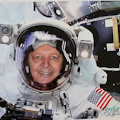
Steve Taranovich
Freelance Technical Writer, Phoenix Information Communication LLC
Steve is a contributing editor to Electronic Design.
Author of the non-fiction “Guardians of the Right Stuff,” a true story of the Apollo program as told by NASA and Grumman Corp. engineers, an astronaut, and technicians.
Experienced Editor-In-Chief of EETimes/Planet Analog and Senior Technical Editor at EDN running the Analog and Power Management Design Centers from 2012 to 2019.
A demonstrated history in electronic circuit design and applications for 40 years, and nine years of technical writing and editing in industry. Skilled in Analog Electronics, Space-related Electronics, Audio, RF & Communications, Power Management, Electrical Engineering, and Integrated Circuits (IC).
1972 to 1988 worked as a circuit design engineer in audio (8 years) and microwave (8 years). Then was Corporate Account Manager/applications engineer for Burr-Brown from 1988 to 2000 when TI purchased Burr-Brown. Worked for TI from 2000 to 2011.
Strong media and communication professional with a BEEE from NYU Engineering in 1972 and an MSEE from Polytechnic University in 1989. Senior Lifetime member of IEEE. Former IEEE Long Island, NY Director of Educational Activities. Eta Kappa Nu EE honor society member since 1970.
